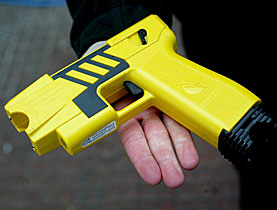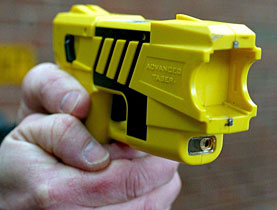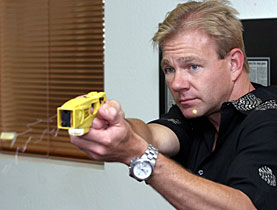Caution urged as Taser law comes into force

Swiss police can use stun guns instead of regular arms under legislation that comes into force on January 1, but opponents have cautioned against their widespread use.
Amnesty International says the guns have been known to kill people and should only be used as a last resort and under strict conditions.
Taser guns were approved as part of a new law applicable from January 1 governing the use of force by federal police and border guards. It aims to ensure a minimum infringement of individuals’ rights by police using violence or weapons.
Plans under the law to allow officers to use Tasers went through several rounds of inconclusive debate in the House of Representatives and the Senate over two years before being agreed by parliament in November.
The law lays down strict conditions for the use of the devices. Among the scenarios where the use of stun guns would be permitted would be an attempted aeroplane hijacking or to overpower people who endanger themselves or others.
But the Swiss branch of Amnesty International says more research is needed into the risks of using stun guns on certain vulnerable groups, such as people with heart problems or those with psychological issues.
Denise Graf, Amnesty’s Swiss police expert, said: “The Taser is used in Switzerland by special intervention forces. The problem could be that if they use it once or twice without any problems that then they could use it more and more and in the end use it in a disproportionate way.”
Transparency
The Federal Justice Office has been asked to prepare an evaluation report on the new regulations after two years.
Colette Rossat-Favre of the Justice Office said: “The law on the use of force also stipulates that the entire use of arms, including stun guns, needs to be reviewed. Reports on the use of the stun guns will form the basis for an evaluation by the Federal Justice Office.”
In the meantime Amnesty will continue to campaign for the Swiss authorities to be more open about their use of stun guns.
“There isn’t any transparency at all concerning the use of Tasers. We will ask the authorities to really openly declare how many times the Taser has been used.”
She said they had to rely on newspaper reports to find out how and when a Taser gun was used, but could not find out for themselves if the use was “proportionate”.
A report by Amnesty International in December found 334 people were killed in the United States between 2001 and 2008 after a stun gun was used on them. Voltage from the guns “provoked or contributed” towards death in around 50 cases.
The report found that around 90 per cent of the people who died after being stunned had not been armed and had not seemed to pose a serious threat to anyone.
Tasers are already authorised by several Swiss cantons, all of which have widespread autonomy for their police work. Amnesty says they were used 21 times by the end of 2007, but did not know in which situations.
“I think one of the risks in Switzerland as in other countries is the use of Tasers against people with psychological problems,” added Graf.
“On the international level we continue to ask for independent studies on the Taser and risk groups. And we continue to ask that the Taser is not used on a large scale and is only used instead of the firearm and under the conditions under which firearms can be used under international rules.”
Common goal
Graf, who authored an Amnesty report on the Swiss police force in 2008, said different cantons were more advanced when it came to respecting human rights during policing and it remained to be seen whether the new legislation would help various authorities to act on a more cohesive level in the use of force.
“Since 2004 big efforts have been made in different police corps. This situation might continue to improve in different cantons. But I am sure that we will still have big differences between the cantons.”
The draft law was designed by a working group made up of cantonal and federal representatives.
Rossat-Favre, the Federal Justice Office head lawyer who oversaw the development of the new law, explained that the new law basically codified what was already in practice among different authorities.
The law will be applicable to central government authorities such as the federal police and border guards each time they use force. It will only apply to the cantons when acting under orders from the government.
“Before the adoption of the new law on the use of force, the cantons and the government had little legislation on the issue,” she told swissinfo.
“This new law is a result of the common desire of the government and cantons to set up clear rules on the use of force.”
swissinfo, Jessica Dacey
The trademark Taser is an acronym for “Thomas A. Swift’s Electric Rifle”. Arizona inventor Jack Cover designed it in 1969 and named it after the science fiction teenage inventor and adventurer Tom Swift.
The Taser uses a temporary high-voltage low-current electrical discharge to override the body’s muscle-triggering mechanisms.
Two barbed darts embed themselves into the skin and deliver a series of around 50,000-volt electrical pulses for up to five seconds. The maximum range of the darts is 10 metres.
Experts say a shock lasting half a second will cause intense pain and muscle contractions. Two to three seconds will often cause the subject to become dazed and drop to the ground. More than three seconds will usually completely disorient and drop someone for up to 15 minutes.

In compliance with the JTI standards
More: SWI swissinfo.ch certified by the Journalism Trust Initiative











You can find an overview of ongoing debates with our journalists here . Please join us!
If you want to start a conversation about a topic raised in this article or want to report factual errors, email us at english@swissinfo.ch.